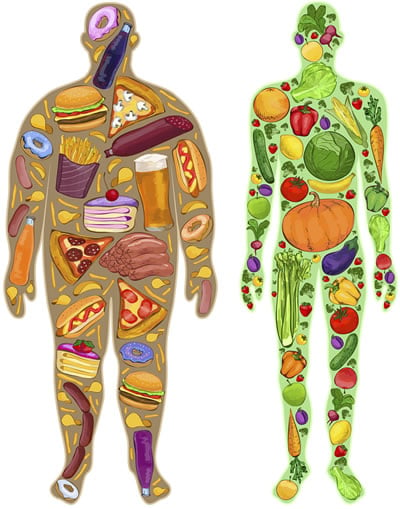How Long Does It Take To Lose Weight?
UCLA researcher R. James Barnard has published 200+ studies in the last four decades on complex issues related to disease prevention, weight control, and lifestyle. But he feels a key rule for a healthy weight-loss plan can be stated very simply…

For more than 40 years, Dr. R. James Barnard in the UCLA Department of Integrative Biology and Physiology has studied conditions like obesity, heart disease, diabetes, hypertension, and cancer, and the impact of healthy lifestyles like the Pritikin Program. He has published 200+ studies on a wide range of subjects, from insulin resistance to prostate cancer to healthy weight-loss plans.
Many of his investigations have involved complex physiological issues, but Dr. Barnard feels that one of his most important conclusions can be expressed in very simple terms:
We must stop focusing on questions like,
“How long does it take to lose weight?”
Far more important is healthy living. With healthy living, weight loss naturally happens.
“When we put weight loss first,” explains Dr. Barnard, “we often set ourselves up for failure.”
“For most people, weight loss happens slowly – usually only about one to three pounds a week,” says weight-loss expert Dr. Barnard.
“When we tell a 300-pound man that his ideal weight is 180 pounds, what good does that do him? He already knows he’s grossly overweight, and setting his sights on 180 pounds seems interminable. Soon, he gets discouraged and quits. But if we put the focus on improving risk factors such as blood pressure, diabetes, and cholesterol, he will likely see major success in a very short period of time.

“His risk-factor success can fuel his incentive to continue with his healthy lifestyle plan. With continued adherence comes weight-loss success. It’s a win-win strategy.”
“We see it all the time at the Pritikin Longevity Center,” notes Pritikin’s Medical Director Danine Fruge, MD. “People arrive here obsessed with losing weight, but they leave us realizing that success encompasses much more than what the bathroom scale says.
“They’re thrilled at the health results they’ve achieved and tell us: ‘I can’t believe how much my cholesterol went down,’ and ‘The last time my blood pressure was this low I was in high school,’ and ‘I never thought I could feel this good again.’
“Best of all, they’re motivated to continue with their healthy new habits when they return home. They’ve learned that while weight loss is slow, getting healthy can happen very, very quickly.”
Understanding the research
If you’ve visited the Pritikin Center, you’re aware of the fast and profound impact of healthy eating and fitness on traditional risk factors like blood pressure and cholesterol, but there are many other benefits related to physiology and healthy weight-loss planning that scientists are now discovering.
Dr. Barnard describes these research findings in his book Understanding Common Diseases and the Value of the Pritikin Eating and Exercise Program. Here are three.
#1
Hormones can dramatically affect body weight.
Hormones, including insulin, cortisol, thyroxin, and estrogen, can significantly influence our metabolism (the rate at which we burn calories) and the amount of fat we store. We’ll focus on insulin in this newsletter issue.
One of insulin’s primary jobs is ferrying glucose (sugar) out of the bloodstream and into our body’s cells.
Getting Healthy Again, Quickly
A growing body of research is finding that for many people, getting healthy again does not require a medicine cabinet full of drugs. Fast and profound benefits can happen simply with good food and daily fitness.
How long does it take to lower blood pressure? And what’s the best way to do it? Here are answers from the physicians and other faculty at the Pritikin Longevity Center, which has been helping people control blood pressure via lifestyle changes for nearly 40 years.
How Long Does It Take To Lower Blood Pressure?
How long does it take to lower cholesterol? How low should you go? Find out from the cardiologists and other faculty at the Pritikin Longevity Center in Miami, which has been helping people lower cholesterol, shed excess weight, and live healthier since 1975.
How Long Does It Take To Lower Cholesterol?
“There is much we can do with a healthy lifestyle alone, no medications needed, to prevent diabetes,” states Dr. James Barnard, Distinguished Professor Emeritus at UCLA and author of more than 200 studies on the relationship between lifestyle habits and chronic diseases like diabetes.
How Long Does It Take To Reverse Diabetes?
#2
The kind of food we eat may be more important than the actual calorie count.
In his laboratories at UCLA, Dr. Barnard and his team have conducted experiments with rodents in which half were placed on a typical American diet (high in fat, sugar, and refined carbohydrates), and the other half ate a Pritikin-style plan rich in whole, unrefined carbohydrates naturally low in fat.
The rodents on the American-style diet became insulin resistant, developed the metabolic syndrome (a pre-diabetic condition), and gained weight, particularly belly fat. The Pritikin-eating rodents did not.2
“What was interesting,” notes Dr. Barnard, “is that the American-diet animals realized that their diet was packed with calories and actually consumed less food compared to the Pritikin-diet group.
“In fact, when food intakes were measured and calorie consumptions calculated, there was no difference in calorie intake between the two groups despite the fact that the American-diet group gained weight and got fat. This research3 demonstrates the importance of paying attention to the kind of foods consumed and not just the calories.”
Studies like this may also help explain why many Americans who work hard trying to lose weight – judiciously counting calories and eating just half of their typical portions of burgers and fries – net so little in return. The bathroom scale barely budges. Some even gain weight. Understandably so, they often give up on their diets.
“On the flip side, our research may explain why many people attending the Pritikin Longevity Center are surprised at how much they can eat, far more than those meager servings of burgers and fries, yet successfully shed weight,” notes Dr. Barnard.
Bottom Line: You can eat more and weigh less when you’re eating the right foods – water-rich, nutrient-rich, fiber-rich whole foods like fruits, vegetables, beans, whole grains, and starchy vegetables like yams, corn, and potatoes.
#3
Reducing saturated fat is good for weight loss and heart health, and also for quelling inflammatory fires.
Fat cells, scientists now know, do a lot more than make us pudgy. They pump out chemicals like inflammatory cytokines that trigger chronic low-level inflammation throughout the body. That’s a big problem because chronic inflammation is thought to be one of the major factors linking obesity to various life-crippling diseases, including heart disease, strokes, diabetes, and even Alzheimer’s disease.
“Probably the most important aspect of the Pritikin Program for reducing pro-inflammatory factors is the program’s substantial reduction in saturated fat intake,” observes Dr. Barnard.
Foods high in saturated fat include red meat, butter, cheese, whole milk, organ meats, processed meats like bacon and hot dogs, coconut oil, and palm kernel oil.
-
Toll-Like Receptors and NFkB
Reducing saturated fat would likely reduce chronic activation of proteins within our cell membranes called Toll-Like Receptors. When these proteins are activated, they flip on the “power switch” of another protein called NFkB, which generates a massive production of inflammatory cytokines.
For many years it was thought that only white blood cells contained the NFkB power switch, but recently researchers have discovered that many other tissues, including fat cells, contain NFkB.
Moreover, scientists at UC San Diego led by Dr. Jerrold Olefsky found that when mice were placed on a high-saturated-fat diet, Toll-Like Receptors were activated, and they induced inflammation. In fact, saturated fats were described as “robustly pro-inflammatory.”4 Inflammatory cytokine levels shot up in the blood circulation, and the mice became insulin resistant – the pre-cursor to type 2 diabetes.
-
Endothelium
Another tissue that is known to contain the NFkB power switch and the ability to produce pro-inflammatory cytokines and related factors is the endothelium – the “skin” that lines the inside walls of our arteries and plays an important role in the development of atherosclerosis, or heart disease. Endothelial cells also contain Toll-Like Receptors, which means that when we eat high-saturated-fat diets, these Toll-Like Receptors turn on NFkB, producing pro-inflammatory cytokines and generating a host of other problems involved in the development of atherosclerosis.
“So not only do high-saturated-fat diets increase serum [blood] cholesterol, they basically, by inducing inflammation, induce the whole atherosclerotic process,” sums up Dr. Barnard.
-
Matrix metallo proteinase-9
And oh, it gets worse. A high-saturated-fat diet, through activation of NFkB, increases production of matrix metallo proteinase enzymes that lead to erosion of connective tissues. Matrix metallo proteinase-9 has been shown to be involved in the rupture of fibrous caps covering cholesterol plaque, which can result in a heart attack or stroke.
To imagine what we’re talking about, think of matrix metallo proteinase-9 as sandpaper that keeps rubbing and rubbing along a boil on your face. Eventually, all that rubbing is going to erode your already-sensitive skin, causing the boil to burst or bleed. This same eroding-rupturing activity is what matrix metallo proteinase-9 does to the cholesterol plaque embedded in the artery wall. When plaques rupture, clots form, choking off blood flow to the heart or brain.
Now for the heartening news…
Within two to three weeks, the Pritikin Program has been reported to substantially reduce (up to 45%)5 blood levels of hs-C-reactive protein, a marker of inflammation, in men, women, and children. C-reactive protein is produced primarily by the liver and released into the circulation when levels of inflammatory cytokines are increased.
Inflammatory cytokines themselves have also been found to drop precipitously with healthy Pritikin living. Research6 following overweight and obese children found that after two weeks on the Pritikin Program, blood levels of pro-inflammatory cytokines TNFa were reduced by 43%, as were inflammatory cytokines IL-6 (by 56%) and IL-8 (by 30%). Similar results have been obtained from adults attending the Pritikin Longevity Center.
Levels of matrix metallo proteinase-97 have also been found to drop rapidly with Pritikin living, “which should immediately reduce the risk for plaque rupture, clot formation, and a heart attack,” states Dr. Barnard.
Healthy living can put us on the best healthy weight-loss plan
“Keep in mind that all these health benefits were achieved before our men, women, and children had lost significant amounts of weight. That’s why it’s so important to focus on these health improvements. They come quickly and dramatically, and they serve as powerful motivators to continue a healthy lifestyle,” says Dr. Barnard.
“As we’ve observed with the many thousands of participants at the Pritikin Longevity Center over the last 40 years, when we focus on healthy living success, we achieve weight-loss success.”
- 1 Journal of Applied Physiology, 2006; 100: 1657.
- 2 Journal of Applied Physiology, 1998; 84: 1311.
- 3 Journal of Applied Physiology, 1998; 84: 1311.
- 4 Annual Review of Physiology, 2010; 72: 219.
- 5 Metabolism, 2004; 53: 377.
- 6 American Journal of Physiology: Endocrinology and Metabolism, 2012; 303: E542.
- 7 Atherosclerosis, 2007; 191: 98.